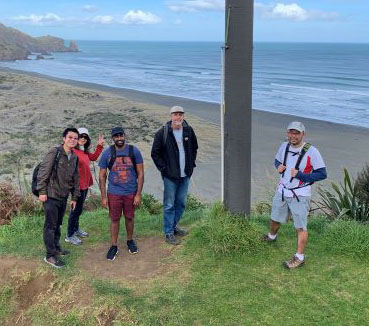Written by Hannah Weems
Jack Rogers, Ph.D., professor in the UAB Department of Biomedical Engineering (BME), recently returned from an international fellowship that allowed him to spend six weeks studying optical mapping of the heart and stomach at the Auckland Bioengineering Institute in the University of Auckland, New Zealand. Rogers received the fellowship in 2020 from the New Zealand Royal Society Te Apārangi through the Catalyst International Leadership Fellowship.
 From left, Hanyu Zhang, Phong Cheng, Nira Paskaranandavadivel, Jack Rogers, and Leo Cheng on the Te Hanga Walkway overlooking Bethels Beach west of Auckland.Rogers’ winning proposal is titled, “Optical technologies for mapping heart and gut function” and seeks to enhance New Zealand’s expertise and technologies in optical mapping of electromechanical function in living organs, specifically in gastrointestinal (GI) systems. Rogers is a global pioneer in the field of optical mapping of the heart and GI system.
From left, Hanyu Zhang, Phong Cheng, Nira Paskaranandavadivel, Jack Rogers, and Leo Cheng on the Te Hanga Walkway overlooking Bethels Beach west of Auckland.Rogers’ winning proposal is titled, “Optical technologies for mapping heart and gut function” and seeks to enhance New Zealand’s expertise and technologies in optical mapping of electromechanical function in living organs, specifically in gastrointestinal (GI) systems. Rogers is a global pioneer in the field of optical mapping of the heart and GI system.
“Optical mapping is used often in the cardiovascular landscape,” Rogers says. “It is a newer idea to use this same technology in the GI system, but we believe it will lead to a clearer understanding of GI motility disorders such as gastropareses and gastroesophageal reflux disease (GERD).” A portion of this research is conducted using pig models, and specifically, collecting data from their stomachs and small intestines to test the implementation of optical mapping in the GI system.
Rogers submitted the grant alongside his New Zealand collaborator Leo Cheng, Ph.D., a Professor in the Auckland Bioengineering Institute. Cheng is a world leader in mapping the electrical activity of the gastrointestinal tract. The two have collaborated for several years to study the electrophysiology of the stomach, which has applications for gastrointestinal motility disorders.
Hanyu Zhang, Ph.D., a postdoctoral trainee in the Rogers Lab, accompanied Rogers on his research trip. Zhang earned his Ph.D. from UAB’s BME Ph.D. program and has been working alongside Rogers for nine years, since 2012. “My specific work,” Zhang says, “was to help build and modify the optical mapping system and its software so it can transition smoothly to a new laboratory.”
He assisted in carrying out a number of experiments, including collecting data from the pig model and piloting experiments for future studies. “It was a wonderful international collaboration and we are making exciting progress in developing gastrointestinal optical mapping technology,” says Zhang.
“What is next for this research is a heavier focus on the intestines rather than the stomach,” Rogers says. “Optical mapping is allowing us to see electrical waves in the GI system in much higher resolution.”
Rogers and Zhang will continue to visit New Zealand for one month each year through 2023 to share and transfer their optical imaging expertise through direct collaboration with both senior researchers and young investigators at the Auckland Bioengineering Institute.
“While we faced a quarantine period and travel challenges due to COVID-19, our time conducting research in New Zealand was fruitful and we look forward to continuing our optical mapping research in this area,” Rogers says.